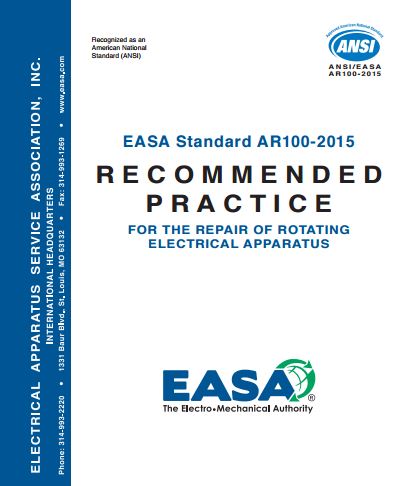
ANSI/EASA Standard AR100-2015 is EASA’s Recommended Practice for the Repair of Rotating Electrical Apparatus. This latest guide is an update to the guide released in 2010 (ANSI/EASA AR100-2010). The American National Standards Institute (ANSI) requires that standards be re-evaluated / approved every five years. This new standards guide contains over 60 changes from the previous 2010 recommended practices.
Below are some of the most significant:
- Clause 1.12 (new): Added a recommendation to indicate an authorization to ship for a completed repair.
- Clause 2.6: Changed balance quality level for machines rated above 2500 rpm to level G1.0; machines rated 2500 rpm and below remain at grade 2.5. (Note: This change will affect service centers that are in the EASA Accreditation Program or are considering accreditation. Effective August 2016, the balance level of G1.0 for motors rated above 2500 rpm will be a requirement for the Accreditation Program.)
- Clause 3.3: Added temperature limits of 700°F (370°C) for cores with organic coreplate and 750°F (400°C) for inorganic coreplate.
- Clause 4.2.7 (previously 4.2.8): Changed evaluation criteria for bearing insulation test, noting that there is no industry consensus for bearing insulation in motors supplied by variable frequency drives.
- Clause 4.3.1: Winding resistance and surge tests should now be per-formed on every repair; previously they were optional. Insulation resistance test also should be performed on every repair. (Note: This change will affect service centers that are in the EASA Accreditation Program or are considering accreditation. Effective August 2016, a calibrated surge tester will be a required pieced of equipment for the Accreditation Program.)
- Clauses 4.3.3 and 4.3.4: Insulation resistance test should now be performed on every repair; previously it was an option.
- Clause 4.5: Added that motors should be secured on a base plate or on a resilient pad for the no-load test. Also, added recommendations for testing AC motors and DC motors that operate at above base speed.
- Table 4-5: Unfiltered vibration limits revised to conform to current NEMA and IEC standards values.
